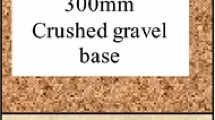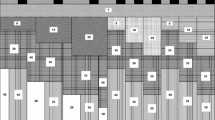Abstract
The prediction of asphalt pavement performance has been the focus of many studies. The characterization of fatigue resistance has been proposed by means of laboratory testing, field data evaluation, and numerical and analytical models. In relation to laboratory characterization, there is no consensus on which test should be performed, on the failure criterion, on the test conditions or on the specimens’ geometry. For asphalt mixtures, the most common tests are the cyclic indirect tension test (ITT), the four-point bending beam test (4PBBT), and the tension–compression (push–pull) test. The present research characterized one hot mix asphalt (HMA), and the results were used in different performance models, including the newly proposed mechanistic-empirical design method for Brazilian asphalt pavements. The results indicate that the conventional prediction model provided by the mechanistic-empirical pavement design guide (MEPDG) tends to overestimate the fatigue life of analyzed asphalt pavement. The main reason for this is attributed to the fact that this model does not consider relevant inputs, such as base layer stiffness, climate conditions, and the viscoelastic characteristics of the asphalt mixture. The proposed Brazilian design method resulted in predicted values of cracked areas that were similar to the values observed in the field, which highlights the importance of the use of models calibrated with respect to local conditions.









Similar content being viewed by others
Availability of Data and Material
Not applicable.
Code Availability
Not applicable.
References
Priest, A. L., Timm, D. H. (2006). Methodology and calibration of fatigue transfer functions for mechanistic-empirical flexible pavement design. Report Number 06–03. National Center for Asphalt Technology, Auburn University, Auburn, AL.
Huang, Y. H. (1993). Pavement Analysis and Design. Prentice Hall.
Park, H. J., & Kim, Y. R. (2013). Investigation into top-down cracking of asphalt pavements in North Carolina. Transportation Research Record, 2368(1), 45–55. https://doi.org/10.3141/2368-05
Zhao, Y., Alae, M., & Fu, G. (2018). Investigation of mechanisms of top-down fatigue cracking of asphalt pavement. Road Materials and Pavement Design, 19(6), 1436–1447. https://doi.org/10.1080/14680629.2017.1303394
Norouzi, A., & Kim, Y. R. (2015). Mechanistic evaluation of fatigue cracking in asphalt pavements. International Journal of Pavement Engineering, 18(6), 530–546. https://doi.org/10.1080/10298436.2015.1095909
Zheng, M., Li, P., Yang, J., Li, H., Qiu, Y., & Zhang, Z. (2017). Fatigue life prediction of high modulus asphalt concrete based on the local stress-strain method. Applied Sciences, 7, 3. https://doi.org/10.3390/app7030305
Sun, Y., Fang, C., Wang, J., Yuan, X., & Fan, D. (2018). Method of fatigue-life prediction for an asphalt mixture based on the plateau value of permanent deformation ratio. Materials, 11, 5. https://doi.org/10.3390/ma11050722
Wang, Y. D., Keshavarzi, B., & Kim, Y. R. (2018). Fatigue performance prediction of asphalt pavements with FlexPAVETM, the S-VECD model, and DR failure criterion. Transportation Research Record, 2672(40), 217–227. https://doi.org/10.1177/0361198118756873
Elnashar, G., Bhat, R. B., & Sedaghati, R. (2019). Modeling pavement damage and predicting fatigue cracking of flexible pavements based on a combination of deterministic method with stochastic approach using Miner’s hypothesis. SN Applied Sciences. https://doi.org/10.1007/s42452-019-0238-5
The AASHO Road Test: Report 7, Summary Report. Special Report 61G. (1962). Highway Research Board, National Academy of Sciences. Washington, DC.
Elkins, G. E., Schmalzer, P., Thompson, T., Simpson, A. (2003). Long-term pavement performance information management system pavement performance database user guide. Report Number FHWA-RD-03–088. Wood Environment & Infrastructure Solutions, Inc, McLean, VA.
Nuñez, J. Y. M. (2013). Caracterização à fadiga de ligantes asfálticos modificados envelhecidos a curto e longo prazo. M.Sc. Thesis, University of São Paulo, São Paulo, SP, Brazil. https://doi.org/10.11606/D.18.2013.tde-19112013-171029 (in Portuguese).
Di Benedetto, H., La Roche, C., Baaj, H., Pronk, A., & Lundström, R. (2004). Fatigue of bituminous mixtures. Materials and Structures, 37, 202–216. https://doi.org/10.1007/BF02481620
Sabouri, M., Mirzaiyan, D., & Moniri, A. (2018). Effectiveness of linear amplitude sweep (LAS) asphalt binder test in predicting asphalt mixtures fatigue performance. Construction and Building Materials, 171, 281–290. https://doi.org/10.1016/j.conbuildmat.2018.03.146
Shafabakhsh, G., Rajabi, M., & Sahaf, A. (2019). The fatigue behavior of SBS/nanosilica composite modified asphalt binder and mixture. Construction and Building Materials, 229(1), 116796. https://doi.org/10.1016/j.conbuildmat.2019.116796
Ziari, H., Amini, A., & Goli, A. (2020). The effect of different aging conditions and strain levels on relationship between fatigue life of asphalt binders and mixtures. Construction and Building Materials, 244, 118345. https://doi.org/10.1016/j.conbuildmat.2020.118345
Ding, J., Jiang, J., Ni, F., Dong, Q., & Zhao, Z. (2020). Correlation investigation of fatigue indices of fine aggregate matrix (FAM) and asphalt mixture containing reclaimed asphalt pavement materials. Construction and Building Materials, 262, 120646. https://doi.org/10.1016/j.conbuildmat.2020.120646
Osmari, P. H., Souza, R. C., Nascimento, L. A. H., & Aragão, F. T. S. (2020). Evaluation of the relationship between the fatigue performance of FAM and AC mixtures based on volumetric characteristics and on the S-VECD theory. Construction and Building Materials, 265, 120294. https://doi.org/10.1016/j.conbuildmat.2020.120294
Zhang, Z., Han, S., Guo, H., Han, X., & Wu, C. (2021). Fatigue performance evaluation of recycled asphalt fine aggregate matrix based on dynamic shear rheometer test. Construction and Building Materials, 300, 124025. https://doi.org/10.1016/j.conbuildmat.2021.124025
Li, Q., Garg, N., Haggag, M. (2014). Evaluation of correlation between phenomenological approach and fracture mechanics approach for asphalt concrete fatigue performance. In: Proceedings of the FAA Worldwide Airport Technology Transfer Conference, Galloway, NJ.
Rowe, G. M. (1993). Performance of asphalt mixtures in the trapezoidal fatigue test. Journal of the Association of Asphalt Paving Technologists, 62, 344–384.
Ghuzlan, K. A., Carpenter, S. H. (2003). Traditional fatigue analysis of asphalt concrete mixtures. In: Proceedings of the Transportation Research Board Annual Meeting, Washington, DC.
Nguyen, M. T., Lee, H. J., & Baek, J. (2013). Fatigue analysis of asphalt concrete under indirect tensile mode of loading using crack images. Journal of Testing and Evaluation, 41(1), 148–158. https://doi.org/10.1520/JTE104589
Ghuzlan, K. A., & Carpenter, S. H. (2000). Energy-derived, damage-based failure criterion for fatigue testing. Transportation Research Record, 1723(1), 141–149. https://doi.org/10.3141/1723-18
Li, Y. (1999). Asphalt pavement fatigue cracking model. Ph.D. Dissertation, Louisiana State University and Agricultural and Mechanical College, Baton Rouge, LA.
Schapery, R. A. (1975). A theory of crack initiation and growth in viscoelastic media. International Journal of Fracture, 11(1), 141–159. https://doi.org/10.1007/BF00034721
Departamento de Estradas e Rodagem de São Paulo, Instrução de Projeto: Projeto de Pavimentação (2006). IP-DE-P00/001. DER/SP, São Paulo SP, Brazil. (in Portuguese).
Monismith, C. L., Secor, K. E., & Blackmer, W. (1961). Asphalt mixture behavior in repeated flexure. Proceedings of the Association of Asphalt Paving Technologists, 30, 188–222.
Verstraeten, J., Veverka, V., Francken, L. (1982). Rational and practical designs of asphalt pavements to avoid cracking and rutting. In Proceedings of the Fifth International Conference on the Structural Design of Asphalt Pavements, Ann Arbor, MI.
Powell, W. D., Potter, J. F., Mayhew, H. C., Nunn, M. E. (1984). The structural design of bituminous roads. Report Number 1132. Transport and Road Research Laboratory, Wokingham, UK.
Thompson, M. R. (1987). ILLI-PAVE based full-depth asphalt concrete pavement design procedure. In Proceedings of the Sixth International Conference on Structural Design of Asphalt Pavements, Ann Arbor, MI.
American Association of State Highway and Transportation Officials (2008). Mechanistic-empirical pavement design guide: A manual of practice, Washington, DC.
American Association of State Highway and Transportation Officials (2015). Mechanistic-empirical pavement design guide: a manual of practice, Washington, DC.
Rajbongshi, P. (2009). A critical discussion on mechanistic-empirical fatigue evaluation of asphalt pavements. International Journal of Pavement Research Technologists, 2(5), 223–226. https://doi.org/10.6135/ijprt.org.tw/2009.2(5).223
Stubbs, A., Saleh, M., Jeffrey-Wright, H. (2010). Investigation into the validation of the Shell fatigue transfer function. In Proceedings of IPENZ Transportation Conference, Christchurch, New Zealand.
Saleh, M. (2012). Calibration and validation of the Shell fatigue model using AC10 and AC 14 dense graded hot mix asphalt fatigue laboratory data. Engineering Journal, 16(5), 127–135. https://doi.org/10.4186/ej.2012.16.5.127
Adhikari, S., & You, Z. (2010). Fatigue evaluation of asphalt pavement using beam fatigue apparatus. The Technology Interface Journal, 10, 3.
Denneman, E., Anochie-Boateng, J., Nkgapele, M., Komba, J. (2011). Revision of damage models for asphalt pavements. In Proceedings of the Conference on Asphalt Pavements for Southern Africa, KwaZulu-Natal, South Africa.
Nascimento, L. A. H. (2015). Implementation and validation of the viscoelastic continuum damage theory for asphalt mixture and pavement analysis in Brazil. Ph.D. In Dissertation, North Carolina State University, Raleigh, NC.
American Association of State Highway and Transportation Officials (2014). Determining the fatigue life of compacted hot-mix asphalt (HMA) subjected to repeated flexural bending. In T321-14. AASHTO, Washington, DC.
Departamento Nacional de Infraestruturas de Transportes (2006). Manual de estudos de tráfego. In Publicação IPR-723, Rio de Janeiro, RJ. (in Portuguese).
Bosso, M., Vasconcelos, K. L., Beja, I. A., Bernucci, L. L. B., Bittencourt, T. (2016). Weigh-in-motion system to monitoring overloading in a Brazilian heavy traffic highway. In Proceedings of the 7th International Conference in Weigh-in-Motion, Foz do Iguaçu, PR, Brazil.
American Society for Testing and Materials (2010). Standard test method for determining fatigue of compacted asphalt concrete subjected to repeated flexural bending. In D7460-10. ASTM, West Conshohocken, PA.
Acknowledgements
The authors would like to acknowledge the financial support of Coordenação de Aperfeiçoamento de Pessoal de Nível Superior (CAPES) (Grant no. 1456520), Conselho Nacional de Desenvolvimento Científico e Tecnológico (CNPq), Petrobras, Agência Nacional de Transportes Terrestres (ANTT) and Arteris Concessionary.
Funding
This work was supported by the Resources for Technological Development (RDT) of Fernão Dias Concession, under the National Land Transport Agency (ANTT) regulation, by the Project No. 001319 and the Contract No. 1.589/13.
Author information
Authors and Affiliations
Contributions
Data collection: IB and LAN; analysis and interpretation of results: IB, KV, VCB, LAN, and LB; draft manuscript preparation: IB. All the authors reviewed the results and approved the final version of the manuscript.
Corresponding author
Ethics declarations
Conflicts of Interest
Not applicable.
Rights and permissions
About this article
Cite this article
Bessa, I., Vasconcelos, K., Castelo Branco, V. et al. Prediction of Fatigue Cracking in Flexible and Semi-rigid Asphalt Pavement Sections. Int. J. Pavement Res. Technol. 16, 563–575 (2023). https://doi.org/10.1007/s42947-021-00148-5
Received:
Revised:
Accepted:
Published:
Issue Date:
DOI: https://doi.org/10.1007/s42947-021-00148-5




